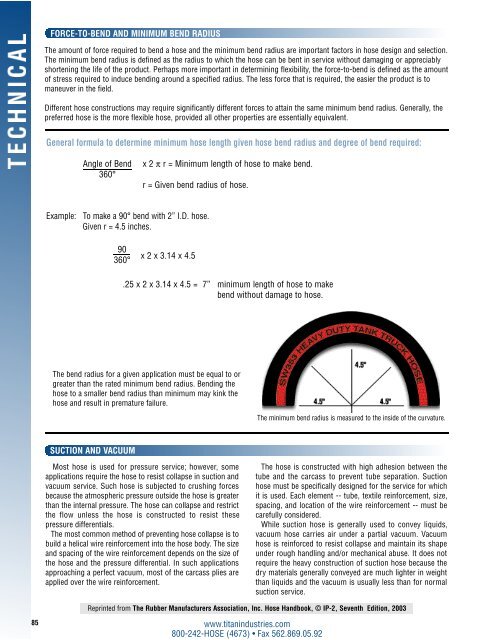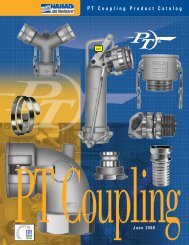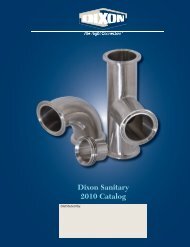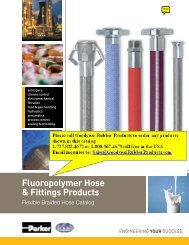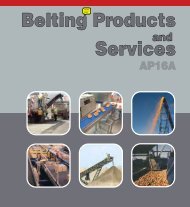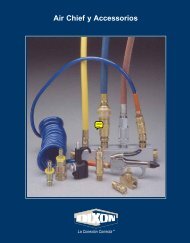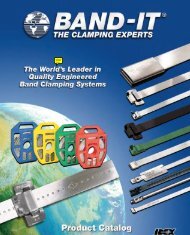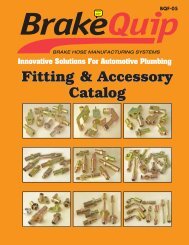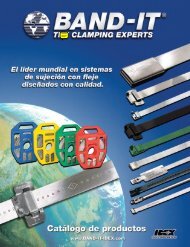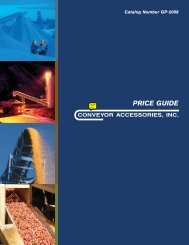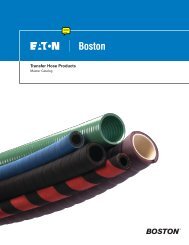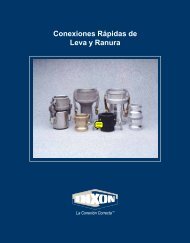Parker Titan Industrial Hose Division - Goodyear Rubber Products, Inc.
Parker Titan Industrial Hose Division - Goodyear Rubber Products, Inc.
Parker Titan Industrial Hose Division - Goodyear Rubber Products, Inc.
You also want an ePaper? Increase the reach of your titles
YUMPU automatically turns print PDFs into web optimized ePapers that Google loves.
85<br />
FORCE-TO-BEND AND MINIMUM BEND RADIUS<br />
The amount of force required to bend a hose and the minimum bend radius are important factors in hose design and selection.<br />
The minimum bend radius is defined as the radius to which the hose can be bent in service without damaging or appreciably<br />
shortening the life of the product. Perhaps more important in determining flexibility, the force-to-bend is defined as the amount<br />
of stress required to induce bending around a specified radius. The less force that is required, the easier the product is to<br />
maneuver in the field.<br />
Different hose constructions may require significantly different forces to attain the same minimum bend radius. Generally, the<br />
preferred hose is the more flexible hose, provided all other properties are essentially equivalent.<br />
General formula to determine minimum hose length given hose bend radius and degree of bend required:<br />
Angle of Bend<br />
360°<br />
Example: To make a 90° bend with 2” I.D. hose.<br />
Given r = 4.5 inches.<br />
90<br />
360°<br />
x 2 π r = Minimum length of hose to make bend.<br />
r = Given bend radius of hose.<br />
x 2 x 3.14 x 4.5<br />
.25x2x3.14 x 4.5 = 7” minimum length of hose to make<br />
bend without damage to hose.<br />
The bend radius for a given application must be equal to or<br />
greater than the rated minimum bend radius. Bending the<br />
hose to a smaller bend radius than minimum may kink the<br />
hose and result in premature failure.<br />
SUCTION AND VACUUM<br />
Most hose is used for pressure service; however, some<br />
applications require the hose to resist collapse in suction and<br />
vacuum service. Such hose is subjected to crushing forces<br />
because the atmospheric pressure outside the hose is greater<br />
than the internal pressure. The hose can collapse and restrict<br />
the flow unless the hose is constructed to resist these<br />
pressure differentials.<br />
The most common method of preventing hose collapse is to<br />
build a helical wire reinforcement into the hose body. The size<br />
and spacing of the wire reinforcement depends on the size of<br />
the hose and the pressure differential. In such applications<br />
approaching a perfect vacuum, most of the carcass plies are<br />
applied over the wire reinforcement.<br />
The minimum bend radius is measured to the inside of the curvature.<br />
Reprinted from The <strong>Rubber</strong> Manufacturers Association, <strong>Inc</strong>. <strong>Hose</strong> Handbook, © IP-2, Seventh Edition, 2003<br />
www.titanindustries.com<br />
800-242-HOSE (4673) • Fax 562.869.05.92<br />
The hose is constructed with high adhesion between the<br />
tube and the carcass to prevent tube separation. Suction<br />
hose must be specifically designed for the service for which<br />
it is used. Each element -- tube, textile reinforcement, size,<br />
spacing, and location of the wire reinforcement -- must be<br />
carefully considered.<br />
While suction hose is generally used to convey liquids,<br />
vacuum hose carries air under a partial vacuum. Vacuum<br />
hose is reinforced to resist collapse and maintain its shape<br />
under rough handling and/or mechanical abuse. It does not<br />
require the heavy construction of suction hose because the<br />
dry materials generally conveyed are much lighter in weight<br />
than liquids and the vacuum is usually less than for normal<br />
suction service.


